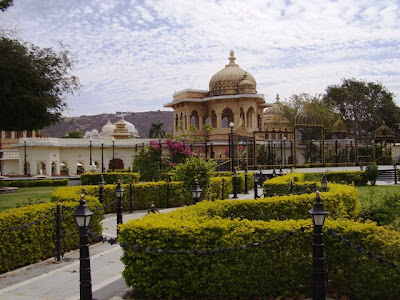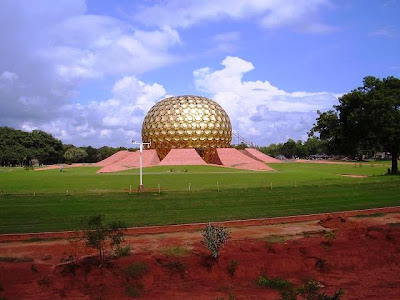As Dave has been promoted to Editor-in Chief, a position in which he will be charged with setting up and running centres of excellence that will produce unique, original and compelling content for this blog, Rejane will start to write the blog content in the first person. Dave's promotion has come as the well-deserved reward for having mastered the art of driving a motorbike on Indian roads. To demonstrate the level of intellectual ability required for this task, a sample multiple choice question has been prepared for anyone thinking of attempting this task anytime in the future.
Instructions - Before attempting the test, please note the following in the diagram below, from top to bottom:
- the arrows pointing in the direction of the traffic flowing south
- below that, the location of Lane#4, followed by Lane#3
- next, the position of the Solid Concrete Barrier/Divider shaded in, in the middle of the diagram, with Gap#1 and Gap#2 in the Barrier/Divider
- then Lane#2 appears, followed by Lane#1
- next, the position of Vehicle X
- finally, the direction of traffic flowing north

MULTIPLE CHOICE QUESTION:
Vehicle X wants to travel
south. What are his "legal" (i.e. permitted by police) options... does he:
A. Enter the highway immediately towards Gap#1 in the solid concrete divider, without looking to determine whether or not there is any traffic coming towards him on the highway, as he has right of way.
B. Enter the highway immediately against the direction of the traffic flowing north, aiming for Gap#2 in the concrete barrier/ divider, without looking as he has right of way and because Gap#2 is closer than Gap#1.
C. After departing from Gap#1 or Gap#2 he should then join Lane#3 or Lane#4 immediately and without looking as he has right of way (nose in front rule).
D. Enter the highway immediately, as he has right of way, turning directly into Lane#1, against the traffic that is traveling in a northerly direction and then continue in Lane#1 on his journey traveling south until reaching his destination 10kms away.
E. Enter the highway immediately, as he has right of way, turning directly into Lane#2, against the traffic that is traveling in a northerly direction and then continue in Lane#2 on his journey traveling south until reaching his destination 10kms away.
**
**
**
**
**
**ANSWER: AT BOTTOM OF PAGE/POST
Although many of you may have some difficulty with passing this test, not Danger Dave, oh no, he passed with flying colours: A clean Indian driving record, with not even an itsy bitsy scratch to speak of by the time we delivered our faithful vehicle back to Lalli Singh in Delhi on 9 March, after 8 exhilarating motorbiking months and 13,000 km. But I'm getting a little ahead of myself here...lots still to tell before that day.
After the 11 glorious days in Hampi we headed to Goa. We had no idea where to start, Goa was developing a reputation for being filled with package tourists and the chilled out, bohemian, backpacker vibe was reportedly now a thing of its past. We wanted to try the beaches in northern Goa as we had seen some of the southern ones when we first arrived in June last year and hadn't been impressed. We headed to Anjuna first but the hotels on the beach were quite expensive and the restaurants were definitely catering to a rather well-to-do class of (Russian) tourist. We decided to try Arambol next but alas, those halcyon days were indeed over, Goa had gotten itself all grown up with the hotels and restaurants out of our budget range and the package tourist vibe not to our taste.
So after spending just 2 days in northern Goa we decided to give the southern beaches one more try. We were hesitant because we had seen the very littered and unattractive southern beaches when we arrived in June but that was during the Monsoon season and we'd been assured by other trusty travelers that the beaches were very different now. We tried Gokarna first which is just over the southern most point of Goa and immediately decided to stay.
Gokarna was completely different from what we had experienced in June. The water had receded from their Monsoonal levels so you could actually see the beach, the rubbish had been cleared up and pretty bamboo and banana leaf huts had been erected for cheap but cheerful accommodation and restaurant venues. From our first day we met some cool travelers that set the tone for long, lazy afternoon lunches, warm ocean dips and afternoon strolls around the area.
 Our beach-side home in Gokarna
Our beach-side home in Gokarna Om Beach
Om Beach Om Beach, where we lodged and spent most of our time hanging out, is so named because it resembles the holy "Om (Aum) Symbol". The symbol, when written in Hindi, looks like the number 3 written backwards. We settled in for a week of indulgence marred only by the groups of Indian men that irritatingly take weekend trips to the beach just to stare at foreigners in bikinis. India really needs to sort out its conservative attitudes towards women and normalise its male/female relations or Indian men might explode with frustration.
 Paradise Beach
Paradise BeachWhen we could drag ourselves away from our hangout on Om Beach we took 30 minute strolls to Paradise Beach (so named because, well, it resembles Paradise).
 Hanging on Paradise beach - read a little, snooze a little, have a spot of lunch...
Hanging on Paradise beach - read a little, snooze a little, have a spot of lunch... Whiling away the hours turning coconut shells into very useful mixing bowels
Whiling away the hours turning coconut shells into very useful mixing bowels Kudlee Beach
Kudlee BeachKudlee Beach was another one of our afternoon stroll destinations from Om Beach (no idea what it resembles or is named after). After a wonderful week or so, it suddenly dawned on us that we had only a couple of weeks left before our Indian visas were to expire and we'd literally have to haul ass to get through the rest of our must-dos before 17 March.
The first stop was 1200kms away (3 hard days of traveling on the bike) on the find-the-family mission. My grandmother was born in Gujarat. Her father was one of 4 brothers of which 2 left India in the early 1900's. Contact with Indian family had eventually been broken as the old people had all long passed on, making this a bit of a mission in the dark. We had no information about my Indian family except a photograph of a young woman and a child with a letter written in Gujarati that we could not read. On arrival in the town of Baruch in Gujarat, our hotel manager kindly translated the letter and offered to help us find the area (there was no house number just a street name). We decided to go the very next morning not knowing what kind of people they'd be or how they would receive us. We arrived in the area mentioned in the letter and started to ask some ladies standing in front of a corner store if anyone recognised the people in the photograph when a young woman walked up to us and exclaimed: "What are you doing with my picture?"! I responded: "I am your cousin from South Africa!"
 Baruch - the street that the family home is in
Baruch - the street that the family home is in The young woman immediately embraced me and introduced herself as Aaisha. She took us straight to the family home where we met her mother and 2 of her 8 sisters.
 Aaisha in front of their house - where my grandmother was born
Aaisha in front of their house - where my grandmother was bornAlthough Aaisha was the only one in the family who spoke any English, we managed to communicate and immediately started trying to work out the family tree while her mom prepared tea, snacks and later a lavish lunch that we enjoyed when her husband returned home from his job as a rickshaw driver.
 Tea and snacks and working out the family tree
Tea and snacks and working out the family treeMy apprehension about how we'd be received was completely unfounded and we had a lovely time chatting about the family back in South Africa and being taken around to the homes of the extended family in the area.
 Meeting the rest of the family
Meeting the rest of the family We enjoyed ourselves so much that we spontaneously decided to invite everyone to dinner at our hotel that night.
 Dinner with the family, Rejane with all the ladies and children
Dinner with the family, Rejane with all the ladies and childrenAlthough we thoroughly enjoyed the reunion and promised to keep the revived family connection alive, time was tight and we had to scoot off the following day for a whistle-stop tour of Rajastan. Rajastan is a well traveled part of India, part of the "Golden Delhi-Jaipur-Agra Triangle" that forms the most visited area in India. We had enough time for only a couple of nights in 3 Rajastani cities: Udaipur, Jaipur and Pushkar.
In Udaipur the main attractions are the "floating" palaces (actually just islands that look like they're floating) that have been converted to luxury hotels charging the equivalent of about R10000 a night, incredible in a country where a 3 year university degree costs R3000 in total and thus a one night stay would see 3 kids through university.
 The Floating Palace in Udaipur, now a fancy hotel
The Floating Palace in Udaipur, now a fancy hotel The majestic City Palace
The majestic City Palace In the lavish gardens of the floating palace
In the lavish gardens of the floating palaceMore than the majesty of Udaipur's palaces, we were pleasantly surprised to bump into some friends we'd made in Hampi, which was a lovely breather amidst our now frenetic and increasingly exhausting traveling pace.
Next stop was Pushkar which we were not very impressed with. We'd hit our temple-viewing saturation point and the markets were nothing we hadn't seen before.
 The Pushkar marketplace
The Pushkar marketplaceOur last stop was Jaipur which is a surprisingly attractive city with buildings all gaily painted pink and the women all beautifully adorned in saris, in all the colours of the rainbow. Sadly we'd left the camera in the hotel room and with no more time to spare, we couldn't go back for any pics :-(
Leaving Rajastan behind, Agra was next on the must-do-before-you-leave-India list. And, yes, we got the obligatory Taj Mahal pics.
 The Taj at sunset
The Taj at sunsetWhile it is, admittedly, a very attractive building designed and constructed with precision symmetry, it is nothing but a tomb that cost the equivalent of US$2 billion to build. You walk in (without your shoes), circle around 2 coffins (an area with a circumference of about 10meters) and you walk out again. The romantic story of Shah Jahan being so heartbroken at his wife's Mumtaz's death that led to the building of the tomb notwithstanding, we couldn't help but speculate how far US$2 billion would go towards alleviating the sheer squalor of the living conditions just metres outside the walls of the monument. Shah Jahan also had a few thousand concubines to console him while mourning...
Video: The Gardens at the TajAfter Agra, it was straight to Delhi to deliver the bike back to Lalli and to catch a train to our last must-do stop at Varanassi. Varanassi is one of the holiest places in India, situated on the banks of the Ganga (Ganges) River. It is considered to be the most auspicious place in the world for Hindus to die and to be cremated. If you die in Varanassi you supposedly skip the endless cycle of re-incarnations and go straight to "heaven". The waters of the river are said to cleanse one of all bad karma past, present and future.
 Washing off all that bad karma
Washing off all that bad karmaVaranassi is a busy place with lots of activity from sunrise to well past sunset when thousands arrive for the daily ceremonies. Sunrise pujas (ceremonies) are performed with chanting and bell ringing reaching a crescendo as the sun pops over the horizon with scores of people arriving all day for a bath, even brushing their teeth and drinking the holy water. The atmosphere is festive throughout the day with tea, samoosas, fresh chappatis and other snacks on sale. After sunrise the large funeral pyres that will burn all day are are built and scores of bodies are cremated, giving the air a distinct smell of braaied meat with the sight of burning bodies and the sound of exploding skulls not for the faint-hearted. Ashes and charred remains are sent down the river along with the whole bodies of children under 10 years old and pregnant women who are never cremated.
The Indian government recently put 18000 scavenger turtles into the river to clear the dead bodies on the river bed and restrictions are increasingly tightened on factories that dump industrial waste although little seems to have been done to provide more appropriate places for people to use as latrines other than the banks of the river...
Video: Daily activity on the riverVideo: A sunset paddle down the holy riverVideo: Fires burning during the nightly funeral pyres along the shore After that wonderful, overwhelming assault on all the senses, it was straight back to Delhi where we met up briefly with our good friend Glynnis from South Africa before boarding our flight to Colombo, Sri Lanka.
And so, it was Namaste and Salaam to India...
**ANSWER TO MULTIPLE CHOICE QUESTION: ALL OF THE ABOVE ( :-o)



































































































